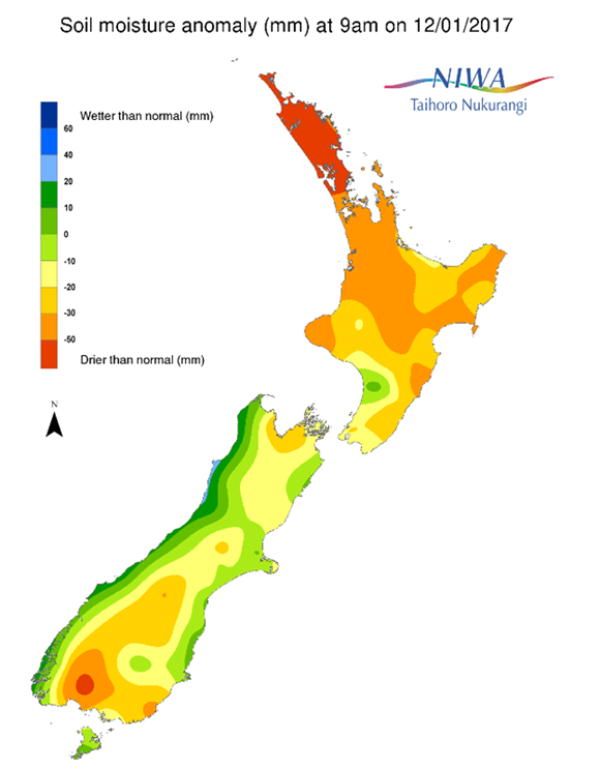A weekly update describing soil moisture across the country to help assess whether severely to extremely dry conditions are occurring or imminent. Regions experiencing these soil moisture deficits are deemed “hotspots”. Persistent hotspot regions have the potential to develop into drought.
Facts: soil moisture
Across the North Island, soil moisture levels have once again decreased almost everywhere during the past two weeks. The most substantial decreases occurred in Taranaki and the Bay of Plenty. A small increase was observed in southwestern Manawatu-Wanganui. The driest soils across the North Island compared to normal for this time of the year are found in Northland and northern Auckland, while the wettest soils for this time of the year are found in southwestern Manawatu-Wanganui.
Hotspots remain in place across nearly the entire eastern coast of the North Island, the Coromandel Peninsula, northern Waikato, Auckland, and all of Northland. Soils in the Coromandel Peninsula, northern Waikato, Auckland, and Northland are extremely drier than normal. Since last week, the hotspot in the northern Waikato has expanded to include parts of the central and southern part of the region. Furthermore, a small hotspot has now developed across southwestern Taranaki.
Across the South Island, soil moisture levels have generally remained the same or decreased over the past week. Small decreases were observed in Nelson and Marlborough, with a larger decrease across interior Otago, Southland, and interior southwestern Canterbury. A marginal increase was observed in coastal middle and northern Canterbury. The driest soils in the South Island compared to normal for this time of the year are found across interior Southland, to the northwest of Invercargill. The wettest soils for this time of year are found along the upper West Coast.
Small hotspots remain in place from coastal to interior Otago and have expanded to include interior Southland and interior southwestern Canterbury. The small hotspot on Banks Peninsula has dissipated.
Outlook and soil moisture
For the North Island, a couple of fronts over the next week will bring some rainfall, particularly across the southwest. In the driest areas (Northland and northern Auckland), less than 5 mm of rainfall is expected over the next week. In central and southern Auckland, Waikato, and much of the east coast, less than 10 mm is likely over the next week. On Friday, light showers will move through northern Waikato, the Bay of Plenty, Auckland, and Northland. Dry conditions on Saturday before another front brings rain, some heavy, to western areas. From the Tararuas through to central Waikato, 10 to 25 mm of rainfall is possible. Some showers may streak into Hawke’s Bay and Gisborne but rainfall is most likely to be 5 mm or less. Only a few showers are expected to make it into Auckland and Northland later on Sunday, amounting to just a few millimetres. Mostly dry Monday, Tuesday, and Wednesday. Another front is forecast to track northward on Thursday of next week, again bringing the most substantial falls to the southwest. Drier conditions by Friday (20th January) and into next weekend; however light showers may continue in the south and east.
Minimal rainfall across the driest regions of the North Island should result in soil moisture level decrease over the next week. Meanwhile, rain in the western part of the island may prove to be beneficial, especially from central Waikato southwestward.
The large hotspot along the east coast and in the northern North Island will remain the same if not continue to strengthen, while the newly-formed hotspots in the central and southern Waikato as well as southwestern Taranaki may see some relief. Over the next few weeks, hotspot activity may develop across the Bay of Plenty.
For the South Island, showers are expected along the lower West Coast, Fiordland, and coastal Southland and Otago with rainfall generally less than 5 mm. More significant rains for Fiordland, the West Coast, and west coastal Tasman from later Saturday into Sunday with up to 25 mm expected. A few showers totalling a millimetre or two for coastal Otago to middle Canterbury on Saturday afternoon. Nelson and northwestern Marlborough may see 5 to 10 mm early on Sunday as well. From Sunday through Tuesday, patches of rain will continue to affect the southern and western portions of the island with amounts 25 to 50 mm along the west coast and less than 25 mm farther inland. Heading into the middle stages of next week, rains will continue in the west but also expand eastward, impacting much of coastal Otago and Canterbury with falls of 10 to 25 mm through week’s end.
Over the next week, soil moisture levels are most likely to remain the same or increase across much of the South Island. There may be a small exception across far northern Canterbury and interior Marlborough, as these regions are likely to be shielded from the most significant rains.
The current hotspots in Otago, Southland, and Canterbury are most likely to remain the same or improve. While new hotspots are not particularly likely to form, an area to monitor for future development is across interior Marlborough and Nelson.
Background
Hotspot Watch: a weekly advisory service for New Zealand media. It provides soil moisture and precipitation measurements around the country to help assess whether extremely dry conditions are imminent.
Soil moisture deficit: the amount of water needed to bring the soil moisture content back to field capacity, which is the maximum amount of water the soil can hold.
Soil moisture anomaly: the difference between the historical normal soil moisture deficit (or surplus) for a given time of year and actual soil moisture deficits.
Definitions: “Extremely” and “severely” dry soils are based on a combination of the current soil moisture status and the difference from normal soil moisture (see soil moisture maps).

